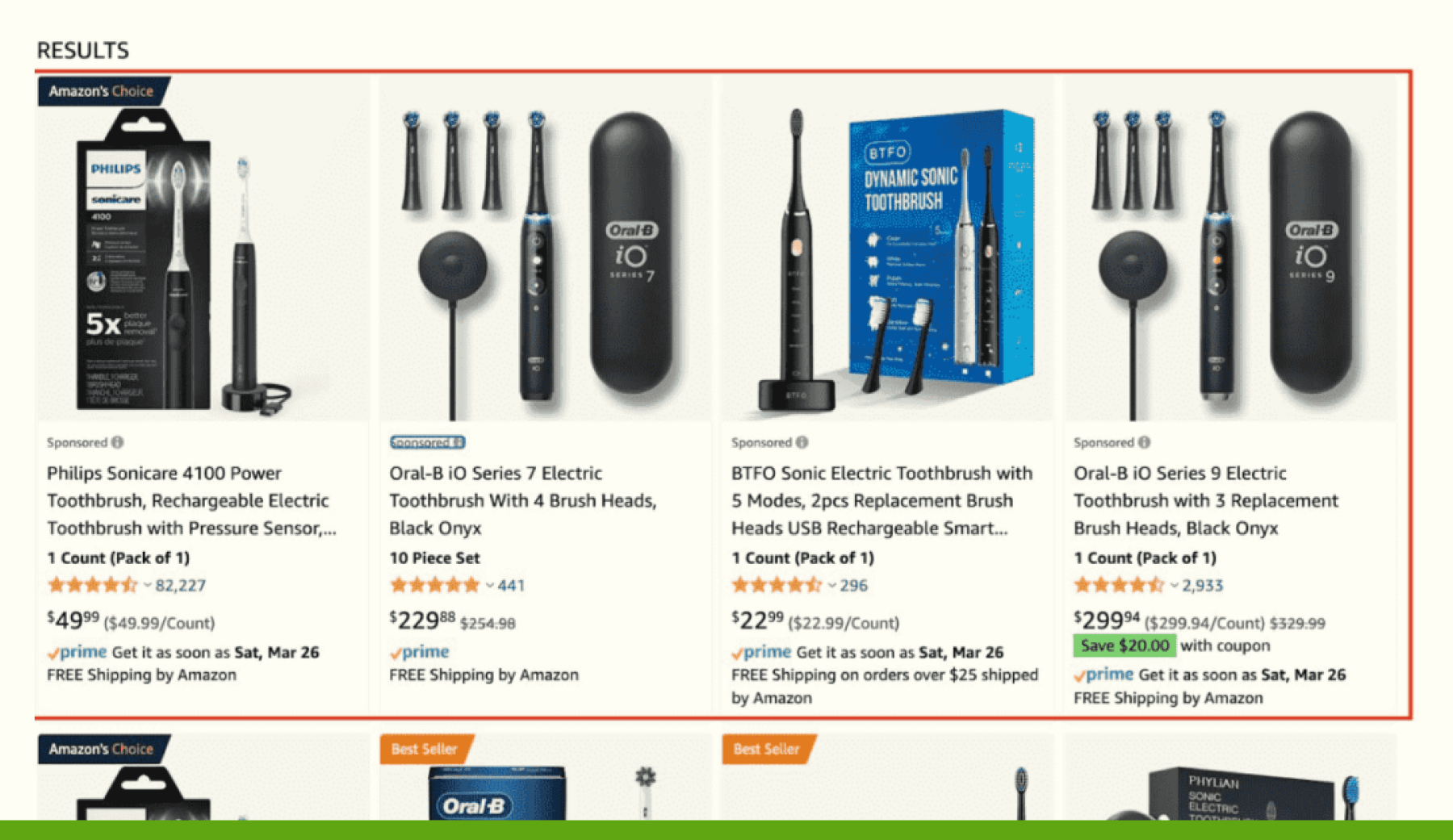to Maximize Returns

Amazon pay-per-click (PPC) advertising is a great way to increase your products’ chances of being seen and purchased by Amazon’s 300 million shoppers worldwide. Amazon enables sellers to target certain keywords, categories, and even competitors with their advertisements.
Whether you are just getting started with Amazon PPC or looking to fine-tune your current strategy for maximum returns, this article explains why and how you should diversify your PPC ad mix, both on and outside of Amazon Marketplace.
There are three different types of Amazon PPC ads available in the Amazon Seller Center:

Sponsored Products are the most popular type of Amazon PPC ads among sellers, largely because you do not need to be enrolled in Amazon Brand Registry, unlike Sponsored Brands and Sponsored Display ads. In fact, Statista found that 56% of brands report that Sponsored Products had the highest return on advertising spending (ROAS).
The first four products at the top of search results are examples of Sponsored Product ads. Sponsored Product ads can be a fantastic way to get your products on the top of page one of search results if you are prepared to spend, but if you fail to bid high enough on your keyword, note that your ads could appear at the bottom of search results.
Sponsored Product Ads may also show on your competitors’ listings, allowing customers to compare options before they buy. While Sponsored Product ads are the most common, Sponsored Brand and Sponsored Display ads can also add significant value if you incorporate them into your PPC strategy.

You know that customers encounter an abundance of choices while browsing on Amazon, but with Sponsored Brand Ads, you can create a customized shopping experience to drown out the noise. Sponsored Brands are banner ads that appear at the top of Amazon search results.
These go one step further than Sponsored Product ads by featuring your company logo, unique headline, and multiple products you carry. Customers who click on your Sponsored Brand ad are sent to your Amazon Storefront—a customized landing page that includes your brand logo, company name, product line, and short company description.
Sponsored Brand Video Ads can help you garner attention in search results with ads that are both captivating and inexpensive, due to lower adoption rates. Video ads can be easily built in the Sponsored Brands creative builder. They can be up to 45 seconds long, with only one product permitted per video.
Although your brand must be registered, Sponsored Brand Video Ads are worth it, with better performance including:
Amazon Sponsor Display Ads have come a long way. They target customers who are not looking for a specific product but may be interested in the types of products you sell. In terms of composition, they can feature text, images, animation, video, and/or audio, and sizes include banner, square, leaderboard, skyscraper, and wide skyscraper.
Most merchants who have been Amazon sellers for a while are heavily invested in Sponsored Products and often have some investment in Sponsored Brand ads. But we like to recommend that sellers also consider investing in Sponsored Display Ads.
Sponsored Display goes far beyond traditional Amazon ads by allowing you to retarget customers who have previously visited your product’s detail page—both on and off Amazon. That includes retargeting across third-party websites and applications. Sponsored Display ads do not target keywords, but instead target particular audience interests and buying behaviors. They offer 4 main cold targeting capabilities:
Because of their versatility, Sponsored Display ads are not just awareness based, but can be used to stimulate activity in consideration, conversion, and even loyalty. They can be especially worthwhile if you have been running Amazon Product Ads for a while and are reaching a point of diminishing returns. That means you should be looking for somewhere to expand with reasonable advertising cost of sales (ACOS) and cost per click (CPC). With Sponsored Display ads, there are no cost minimums.
Each Amazon PPC ad type can be effective depending on your brand’s target market and objectives. To learn more details and step-by-step instructions for each ad type, check our Ultimate Guide to Amazon PPC Ads here.
Agital helped popular cooking supply brand Cooking Gift Set Co. devise and test new strategies within their account to find the best campaign mix for targeting Amazon shoppers during the holiday season to ignite year-over-year (YoY) revenue growth.

Whichever ad types you choose to run, these general tips will help you succeed in boosting your Amazon ad performance:
While it might seem counterintuitive, Amazon favors sellers who promote their products on other platforms and prioritizes traffic from outside of Amazon. When you bring people to Amazon, the algorithm rewards you for driving traffic to its marketplace on top of considering your sales velocity and keywords.
With Amazon Attribution, you can easily market your Amazon products on non-Amazon platforms that span search, social, display, video, email, and third-party affiliate marketing (think Google Ads, Meta Ads, TikTok Ads, website links, and more).
That means that sellers on Amazon should diversify your marketing and advertising beyond testing different Amazon PPC ads by diving into other platforms. Not only will this make your brand more resilient, but it will solidify your ranking on Amazon.

Amazon Delivery Service Partner (DSP) enables programmatic buying of display, video, audio, and in-app ads both on and off Amazon. DSP helps you reach relevant and engaged audiences on Amazon-owned platforms such as Fire TV, Audible, ShopBop, Twitch, Zappos, and Prime Video. You can also leverage advanced audience targeting using 1P behaviors from Amazon shoppers, Whole Foods Shoppers, Prime Video streamers, etc.
Programmatic optimization ensures performance metrics are met and that budgets are balanced. DSP fuels Amazon’s algorithm using off-Amazon traffic to drive Amazon sales and better rankings.

Pacvue allows you to aggregate marketplace advertising across various different marketplaces, with advanced features for improving performance. It helps you:
SOV allows brand health measurement and competitor research. Look at the SOV of your competitors to identify:
Pacvue normalizes your planning and reporting experience across Amazon, Walmart, and (through an integration with Criteo Retail) Target. You can create rule sets to optimize budgets and performance across marketplaces and find new opportunities for optimization.

Today, Amazon rewards you for embracing a holistic advertising strategy. You can build awareness targeting, search consideration, retargeting, and conversion optimization by using cross-channel marketing for Amazon ads across other PPC channels. And the other PPC channels are also on board.
There is a “Buy with Amazon” option in Meta Ads. Pinterest is on a path to make every pin shoppable by easily connecting them with associated Amazon listings. Amazon’s reporting lets you organize your data by channel, e.g. all Meta vs. all Google, and identify which keywords, creative, and products are working the best.
At Agital, we have developed specific methodologies to help our clients plan effective holistic marketing strategies. Holistic marketing helps you stop being too channel-specific, empowering your brand to reach new customer segments, provide a seamless journey, and drive meaningful results for your business.
By meaningful results, we mean increasing customer lifetime value (CLV) and new customer acquisition with proper performance methodology. We also support clients in their messaging methodology, which is how you organize your ads by audience segment to reach the right person at the right time to engage them in high-value actions.
That’s how we’ve helped many leading brands drive serious growth and ROI using PPC ads:
If you’d like us to reach out to discuss your paid search strategy, audit your current Amazon PPC ads, or share some ideas about how your brand can improve customer lifetime value and/or new customer acquisition with an optimized, holistic marketing approach, please click “Let’s Talk” below. Our expert team is here and eager to help you.
